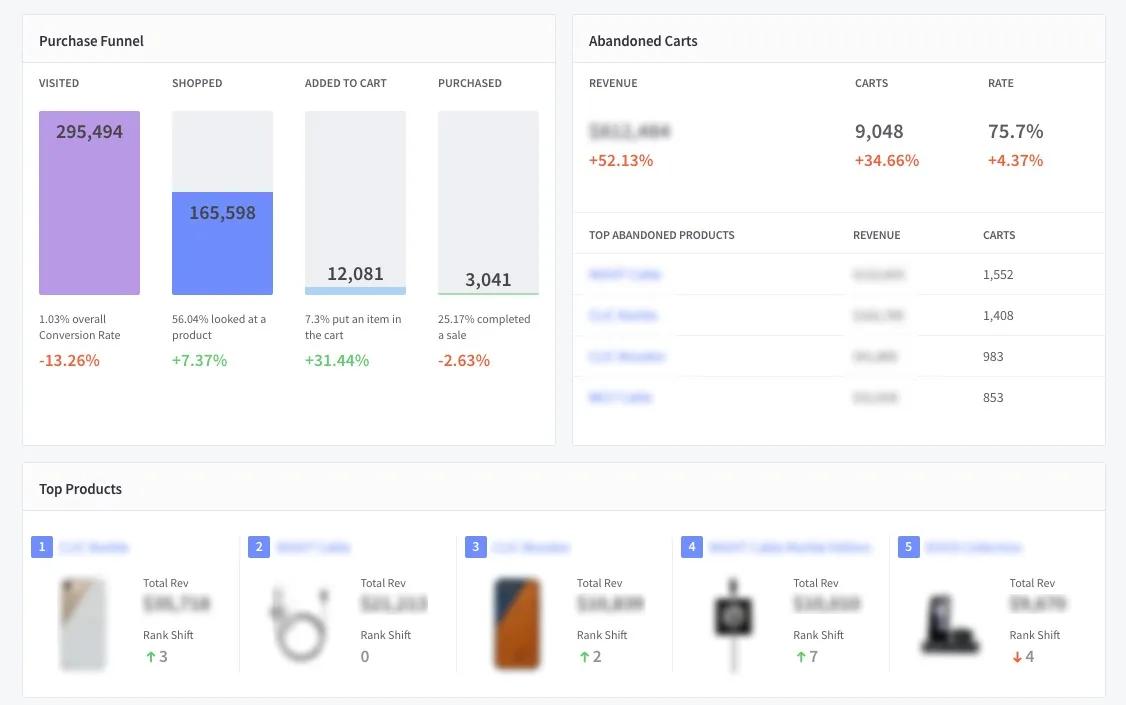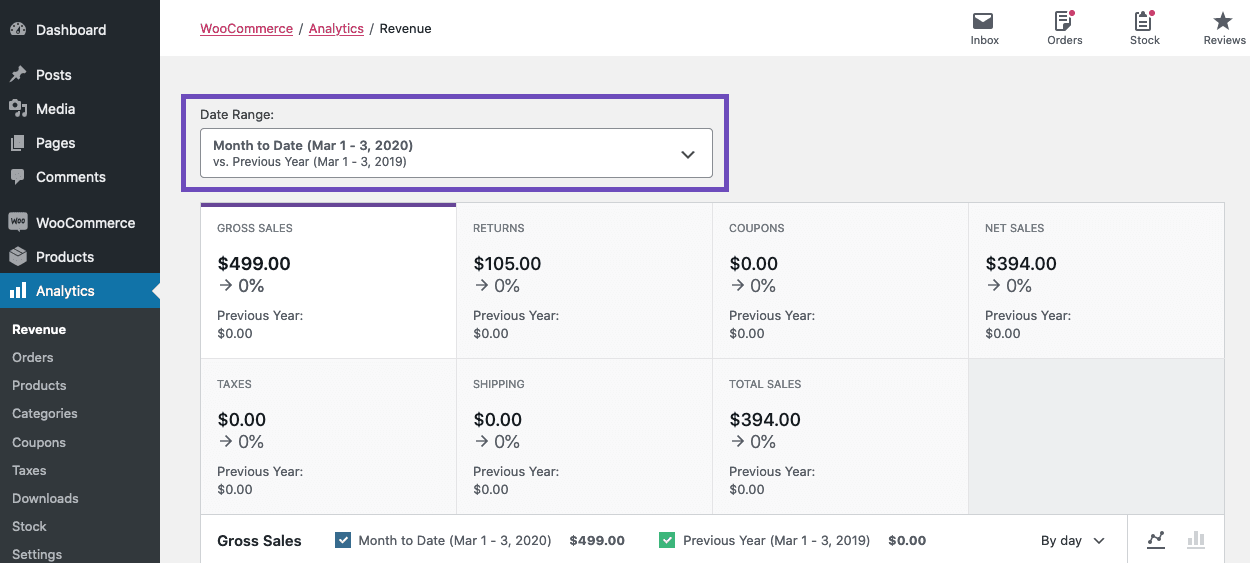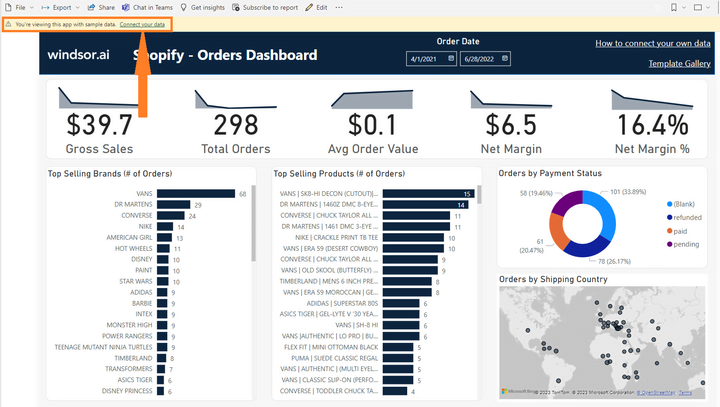How to Use eCommerce Data Analytics to Increase Revenue

Remember when running an online store meant simply listing products and hoping for the best? Those days are long gone. In today’s eCommerce landscape, your data, like a treasure map, can lead you straight to business success if you know how to read it properly.
With the explosive growth of online shopping (and people’s reliance on it), we’re naturally seeing a spike in the number of offers and platforms offering what the audience needs.
Yet, here’s the catch: while the market grows (eCommerce sales are projected to grow by another 39% by 2027), so does the competition. Keeping your customers in the loop becomes harder as they change their minds in a second.
So, to survive in this highly competitive field, you need constant access to data.
Think about it: every click, every cart abandonment, and every completed purchase tells a story. And using these insights properly helps you create personalized shopping experiences that your customers will love returning to.
And the best part is that you don’t need to be a data scientist to make this work for your business.
In this article, we’ll dive into how you can take your data analysis for eCommerce to the next level. Whether you’re just starting out or looking to optimize your existing operations, this guide will show you exactly how to turn your data into a powerful growth engine.
Types of data analysis for eCommerce platforms
The real power of data analysis lies in turning numbers into action. With different data types, you can spot exactly which products are trending up or down, identify your most profitable marketing channels, and even predict inventory needs before they become urgent. Plus, you’ll find ways to streamline your operations and cut costs without sacrificing quality.
From optimizing your contract storage processes to fine-tuning inventory management with software solutions, data analysis helps you make informed decisions across all aspects of your eCommerce business.
Even though any advancement in data analysis is crucial, you should understand that not all eCommerce platforms handle this data in the same way. Each platform has its unique approach to helping you understand your business performance: some excel at user-friendly dashboards, while others offer deep technical capabilities for custom reporting.
The key is understanding what each platform offers to maximize your chosen tools. Let’s examine the three most popular choices for eCommerce teams.
1. Data analysis for Shopify
Shopify store owners have access to powerful analytics tools that can reveal crucial insights about their business performance. Think of Shopify’s analytics system as your 24/7 business consultant, constantly gathering and analyzing data to help you make smarter decisions.
Here’s what you can do with Shopify’s built-in analytics tools:
- Track sales patterns in real-time to spot emerging trends
- Understand how customers move through your store
- Adjust your inventory based on actual demand
- Measure which marketing efforts deliver the best ROI
The real magic happens when you start discovering unexpected patterns. You might find that your bestsellers peak at unusual hours or that certain product combinations drive higher average orders, giving you the opportunity to reshape your entire business strategy.

The platform perfectly suits retail brands, drop shippers, and DTC businesses that want quick, practical insights without getting bogged down in technical setup.
Best data analysis practices for Shopify:
- Combine sales reports with inventory data to optimize your stock levels and prevent stockouts.
- Use customer behavior reports to inform your store’s layout and product placement.
- Create customer segments based on purchase history to target marketing campaigns more effectively.
- Monitor your checkout funnel metrics daily to spot and fix conversion issues quickly.
2. Data analysis for BigCommerce
BigCommerce elevates analytics to a higher level, especially for larger operations. Its enterprise-grade tools help you manage complex sales data across multiple channels while keeping everything organized and actionable.
While enterprises should consider partnering with an experienced Angular development company to set up a custom analytics infrastructure, BigCommerce’s services are more than enough to get started with data analysis. Organizations can further explore comprehensive eCommerce web development solutions to enhance their digital platform capabilities.
Along with the functionality of Shopify’s data analytics, BigCommerce also helps its users with:
- Detailed mapping of customer journeys from first click to purchase
- Clear visibility into where potential sales drop off
- Easy-to-understand tracking across all your sales channels
- Smart customer grouping for targeted marketing campaigns
In a nutshell, this platform connects the dots between different aspects of your business. You can see how social media marketing impacts email campaign performance, which pricing strategies work best for specific customer groups, and which products perform better on different channels.

BigCommerce’s data reporting example. Source: BigCommerce
BigCommerce analytics are ideal for established businesses with $10M+ annual revenue and companies managing multiple sales channels.
Best data analysis practices for BigCommerce:
- Implement cross-channel tracking to understand how customers interact across different platforms.
- Use advanced segmentation to create detailed customer profiles based on behavior and purchase history.
- Sync your data with other tools to create a custom Power BI dashboard and keep an eye on the metrics across multiple channels.
- Connect real-time inventory analytics to optimize stock levels across multiple locations.
- Create automated reports for different stakeholders focusing on their key metrics.
3. Data analysis for WooCommerce
What sets WooCommerce aside from its counterparts is complete flexibility in how you track and analyze your store’s performance. Since it’s built on WordPress, you get unique insights into how your content strategy drives sales.
There are a few key advantages of WooCommerce analytics:
- Deep integration with your content marketing efforts.
- Customizable tracking for specific business needs.
- Flexible reporting options through various plugins.
- Detailed product performance metrics.
If you want to understand the connection between your content and sales, this platform is the perfect option for you. You can track how blog posts, product descriptions, and other content directly influence purchasing decisions. This is particularly beneficial for print on demand products, where engaging content and storytelling around a product can significantly impact sales.

WooCommerce’s data reporting example. Source: WooCommerce
WooCommerce analytics work best for content-driven eCommerce businesses of any size and organizations deeply invested in WordPress.
Best data analysis practices for WooCommerce:
- Install and configure Google Analytics with eCommerce tracking for deeper insights.
- Set up custom event tracking to monitor specific user interactions.
- Create detailed product performance reports linking sales to content engagement.
- Use UTM parameters to track the effectiveness of your content marketing.
- Implement enhanced eCommerce tracking to understand shopping behavior.
Key differences and similarities between platforms
While each platform has its own approach to analytics, they share some common ground. They all track essential metrics like conversion rates and average order values. However, each platform has its strengths:
- Shopify best provides user-friendly analytics that works right out of the box.
- BigCommerce offers easy-to-understand tools for complex, multi-channel operations.
- WooCommerce gives you a higher level of flexibility to customize your analytics setup and analyze your content marketing ROI.
How to use eCommerce data analytics for revenue optimization?
While collecting data is important, the real business impact occurs when you turn those numbers into strategic decisions that increase your bottom line.
Take a look at these few strategies for using data analytics to optimize every aspect of your eCommerce business, from pricing to customer retention.
Identifying key metrics to track
Rather than tracking every possible metric, eComm success is all about the numbers that truly impact your bottom line. Below are the essential metrics you should monitor and how to use them.
Revenue metrics:
- Conversion rate:
- Average order value (AOV)
- Customer acquisition cost (CAC)
- Customer lifetime value (CLV)
- Return on ad spend (ROAS)
Performance indicators:
- Cart abandonment rate
- Product return rate
- Inventory turnover
Pro tip: If you’re running any additional marketing tactics to amplify your growth (such as LinkedIn Ads), don’t forget to use the data from your LinkedIn Ads tool to carefully calculate CAC and AOV, as all the expenses contribute to the final KPIs you’re relying on.
Using data analysis to understand customer behavior
Understanding how customers interact with your store is similar to mind reading. Although you can’t do it in real life, a proper purchase pattern analysis can help you do it for your eComm business.
Here’s what you can do to start understanding your customers a bit better:
- Track the customer journey from the first touch to purchase.
- Identify common paths to purchase.
- Notice where customers typically drop off.
- Monitor seasonal buying patterns.
- Analyze device preferences for shopping to adjust your copy and user experience.
Some advanced analytics tools will also let you customize your segmentation, track engagement, or even calculate the browse-to-buy ratio. All this data is essential for doing your homework later and keeping the retention rates up.
Pro tip: If you see that your abandonment and churn rates are connected to the functionality and user experience of your store, it might be high time to consider eCommerce website redesign. After all, first impressions make all the difference in a flooded market.
“In today’s digital landscape, customer behavior data is your business’s crystal ball. While your competitors are still guessing, your data can reveal exactly what customers want before they even ask. In an era where customers expect nothing less than perfection, being first to understand their needs becomes a survival kit.”
Iurii Znak, CEO at Respect.Studio
Optimizing marketing strategies with data
Effective brand advertisement management in eCommerce is crucial for understanding and analyzing your marketing ROI. Instead of spreading your budget thin across multiple channels, use data and various digital marketing tools to identify and double down on what works best for your specific audience.
Begin by analyzing the complete customer acquisition journey to understand which marketing touchpoints lead to the most valuable customers.
Then, pay attention to:
- Channel performance and the cost-to-quality of customers acquired ratio
- Content engagement patterns across different channels and formats
- Campaign performance metrics driven by ROI
Don’t forget about continuous deployment tools and testing: sometimes, you need several iterations to know what works for sure.
Implementing data-driven pricing strategies
Pricing strategy in eCommerce needs a balance between competitiveness and profitability.
Start by analyzing your market position and understanding how price changes affect conversion rates across different product categories. A strategy map maker can be a helpful tool in this process. can be a strategy map maker, allowing you to visually represent how your pricing decisions relate to other key business objectives.
Define your:
- Market position and competitor pricing trends over time;
- Price elasticity (how your supply and demand depend on the price change);
- Margin impact analysis, including all costs (shipping, processing, returns).
Your pricing strategy should be responsive to market changes while maintaining profitability. Consider implementing automated pricing based on demand, competitor prices, and inventory levels.
Pro tip: Analyze the impact of promotional pricing on long-term customer value. Sometimes, a short-term margin hit can lead to valuable long-term customer relationships.
Streamlining day-to-day operations
One of the many advantages of data analytics is its ability to create a clear roadmap for further actions. The data will help you align the optimization process with actual tasks handled by your team.
For instance, if you’re spotting a single important tendency in your customer data, visualize it for the team using hill charts and allocate new tasks and roles based on your chosen direction.
When the optimization process requires more time and effort, use the agile Gantt chart to delegate the processes and see how they interact with each other within the project timeline.
After all, the goal of any data insight is to make your business better, so using the data’s maximum potential is never a bad idea.
Improving customer retention and loyalty through data analysis
Everybody knows that acquiring a new customer is more expensive than keeping an old one. Data analytics is your key to finding out what works (and, more importantly, what doesn’t work) for your existing customers.
Think about:
- How satisfied are the customers who completed a repeat purchase;
- The loyalty options you have and their impact on retention;
- How your customers behave right after completing the purchase.
Data analysis provides all these insights, so your task is to use them to determine the optimal times to contact customers, personalize your communication based on their preferences, and create targeted offers that encourage loyalty.
Useful tools for eCommerce data analytics
Although gathering quality data is essential, what actually matters is your opportunity to use this data in context. For example, if you’re seeing a significant increase in cart abandonment rates, just knowing this isn’t enough.
And that’s exactly where data analytics tools come in handy: they are designed to gather and connect all the data in one place (for example, a CRM or a dashboard) so you can immediately act on it.
Let’s look at two powerful AI tools that will take your data analytics to a new level:
Windsor.ai – best data integration tool for eCommerce
Windsor.ai is a data integration platform that helps users extract and visualize data from different sources without doing any manual work. Acting as a bridge between your data and actionable insights, it takes seconds to craft cross-channel reports.

Example of a Shopify reporting dashboard created by Windsor.ai
Windsor.ai is a perfect match for teams that:
- Sell across different platforms (Shopify, BigCommerce, WooCommerce) and need to unify their data in one place;
- Use multiple marketing platforms and need to understand how their efforts perform across channels;
- Have no technical expertise but require the versatility of data reporting to grow their business
- Spend a lot of time creating Looker Studio dashboards (or its alternatives) to visualize and analyze customer data.
There are several features eCommerce development teams can benefit from. For instance, you can easily connect major eComm platforms to a single data stack like:
- Integrating data from Shopify
- Visualizing your BigCommerce reports
- Connecting your WooCommerce data to the destination of your choice
All without writing a single line of code.
Coefficient
Coefficient is another powerful tool for eCommerce businesses that live in spreadsheets and rely on Shopify data to get insights into their business operations.

This solution will be an excellent fit for eCommerce teams who need:
- Spreadsheet-based analytics
- Real-time data synchronization
- Advanced reporting capabilities without leaving the spreadsheet
Conclusion
Running an online store gets more complex every day. But with smart data analytics and tools like Windsor.ai, you have everything you need to face this challenge on your terms.
Remember: every customer interaction is an opportunity to learn and improve. By making data-driven decisions and using the right tools, you’ll build a business ready for whatever comes next.


